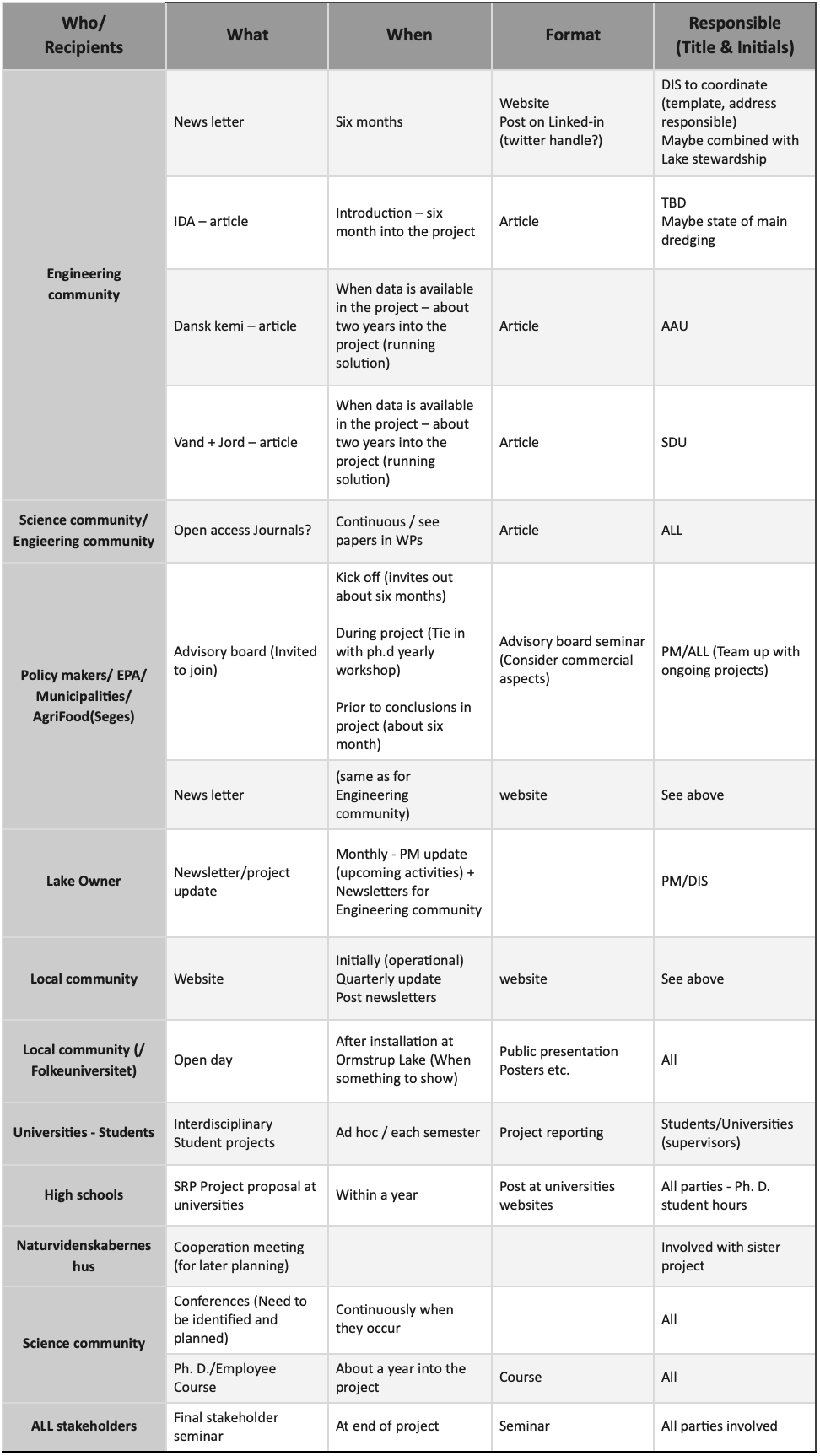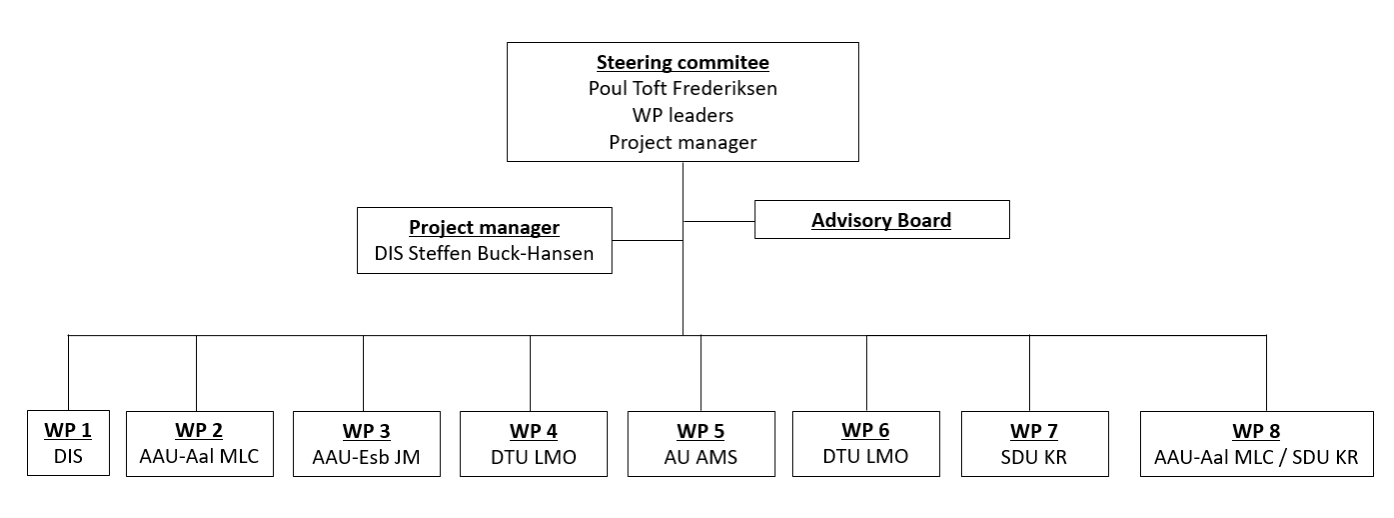Impact of the project
RePair aims to convert the new tools, knowledge and solutions to commercial products or solutions for circular lake restoration and to transfer knowledge from academia to the general public and non-academic sector. In addition, RePair aims at training the future generation of “P specialists” with a high-quality, interdisciplinary program. This training will strongly impact the students professional development, launching them on a successful career path from which the national as well as European community will benefit. The RePair training has a special focus on key scientific and societal skills within an interdisciplinary framework. These skills are currently lacking in today’s work force. Students (MSc, BSc and PhD) will work with pilot-scale and full-scale equipment, which is often difficult at the university, but an important competence (Wiebe 2015)
Impact on society will depend on the specific projects in RePair as follows:
- In the area of P capture, the combination of skills in analytical chemistry, materials functionalization, and ecology is sought after by research and teaching institutions, the agri-food industry, water utilities, environmental technology suppliers (e.g., wastewater treatment and water management), the pharmaceutical and materials science industry as well as by quality control and regulators.
- P recovery methods, including advancements in membrane technologies, are increasingly being implemented all over Europe driven by legislation like in Germany and Switzerland. Stakeholders see the need for circular economy solutions, especially for P, as it is a critical resource. However, there is still a demand for more cost-effective solutions and recovery products that are more in line with market demands.
- An urgent environmental problem for our freshwater systems is P runoff from agriculture and P loss from wastewater, where knowledge about P availability in dredged sediments is crucial for making lake restoration circular. This is a key priority for environmental agencies and regulators. RePair aims to get ahead of the game. Hence, by acting now, the partners in RePair can be at the forefront of transforming lake restoration to a circular economy, securing themselves leadership roles in industry, policy and science.
- Our focus on society responds to the need for interdisciplinary and transdisciplinary professionals that are able to address complex socio-ecological problems by using their knowledge in the natural and social sciences to respond to the GPC. These interdisciplinary and transdisciplinary “knowledge brokers” are widely recognized to be necessary as the multifaceted nature of environmental problems (P and beyond) is irrefutable. Environmental agencies and policymakers at all levels are seeking such professionals so that end-user oriented solutions can be developed.
The RePair project has a special focus on key scientific and societal skills within an interdisciplinary framework. These skills are currently lacking. In addition, RePair will help address 7 of the 17 SDGs demonstrating the high societal relevance of the training program.
Dissemination of the research results
RePair will develop sought-after expertise and know-how in a range of research areas and the generated knowledge will be managed carefully. Non-exploitable knowledge will be disseminated through a variety of means, e.g., across the extensive and cross-cutting networks that all the partners bring, which covers non-academic and academic partners across the globe. It will be an important task to inform non-academic about our activity to ensure greater awareness of the global P challenge i.e. pollutants of lakes and how it can be handled, and more importantly, transform the public understanding of P in lakes emphasizing that P is a resource that has to be recovered and reused. The results will be disseminated as follows:
- The partners will develop lectures for high school students and inspiration materials for SRP tasks to create increased interest in science and the SDG.
- The partners will use the additional expertise gained to provide high-level teaching to their students as well as to scientists and environmental experts employed in industry and academia. Bachelor and master projects will be arranged with part of the work done at the site to introduce students for pilot-scale operations.
- The partners will publish papers in Danish trade magazines to inform relevant stakeholders, companies and authorities.
- The partners will jointly publish research papers in high-impact open access journals.
- Academic partners can also expect to benefit from participating in future research projects where the technology and knowledge will be employed advantageously and disseminated to relevant stakeholders.
- Press releases will inform the public about the overall progress of the project and major breakthroughs achieved by the RePair partners.
- International conferences and the European sustainable phosphorus platform (ESPP) are major channels for dissemination. Besides specialized conferences targeting the needs of each RePair partner, all RePair partners will jointly attend the European Sustainable Phosphorus Conference.
- The RePair partners will use the ESPP to disseminate their research results in, e.g., the SCOPE newsletter (hosted by ESPP), thereby reaching out to more than 44,000 stakeholders from industry, academia and society.
- Efforts will be made to meet, inform and collaborate with other projects (e.g., RecaP)
in the fields that are being run in parallel to RePair.
- Students at the four universities will be involved in the research project (e.g. bachelor and master project) in WP2 - 8. It is expected that this will result in >20 students projects at the end of the project.
A list of activities are given in table 1.

Table 1 Dissemination activities
Governance

Figure 8 Project organization
Steffen Buck-Hansen will be the manager of the project and ensure coordination and progress of all tasks. Poul Toft Frederiksen heads the steering group as the project owner to ensure that the project progresses towards commercialization of the technology. The steering group decides the direction of the project, and the project manager coordinates the project activities according to the direction given from the steering committee. The committee will have monthly meetings to ensure the progress of the project and that deliverables are achieved. WP leaders and their group members are responsible for executing work packages and committing to the goals and visions of the project. Every six months there will be seminars for all team members of the project, where status, results and challenges are discussed. There will be regular meetings (e.g. online via. Teams) between WP group members at least monthly to coordinate the work. An advisory board will be established, including at least one member from the agri-food sector, technology supplier, technology provider, and policymaker. Two meetings will be arranged, one at the beginning and one at the end of the project. The advisory board is expected to give input to the project and critically discusses the project plans and dissemination plan.
The consortium will have a patenting and licensing policy to protect IPR and ensure that the findings can be implemented and commercialized. The IPR will be ensured by the steering committee following a cooperation agreement. This will set up the IPR rules, rights for exploitation, confidentiality and licensing rights. The partners agree that the IPR will belong to the inventing/generating partner(s). This procedure is well established by the contract unit at AAU, where there is a long history for industry collaboration.
